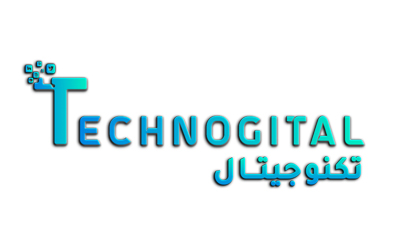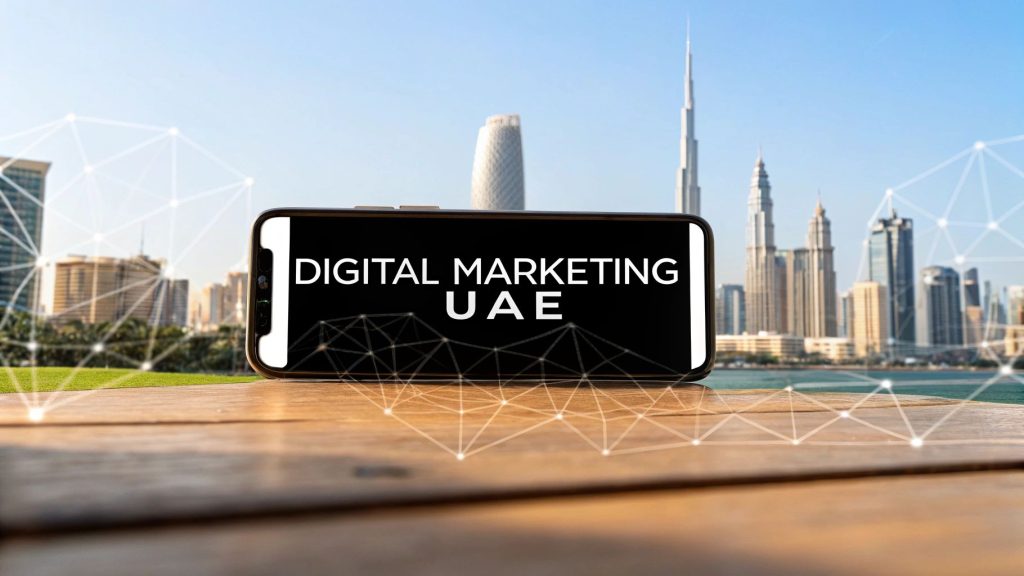To get digital marketing right in the UAE, you first have to understand the people you’re trying to reach. This isn’t just any market; it’s one of the most digitally plugged-in populations on the entire planet. For businesses here, this isn't just an interesting fact—it’s the very air modern commerce breathes.
Understanding the UAE's Hyper-Connected Audience
Picture a marketplace where nearly every single potential customer is online, almost all the time. That’s not some futuristic vision; it’s the reality on the ground in the United Arab Emirates. Before you even think about launching a campaign, you need to get your head around this unique environment, where digital life and daily life have completely merged.
This level of connectivity changes everything for a business. Old-school marketing tactics take a backseat when your entire audience spends their commutes, coffee breaks, and shopping moments scrolling through their phones. It makes a strong digital presence an absolute, non-negotiable necessity.
A Nation Defined by Digital Saturation
The numbers behind the UAE's digital life are genuinely eye-watering, and they paint a crystal-clear picture for any marketer.
Here’s a quick snapshot to set the scene. These statistics show just how deeply digital is woven into the fabric of daily life in the Emirates.
UAE Digital Connectivity at a Glance
| Metric | Figure | Penetration Rate |
|---|---|---|
| Cellular Mobile Connections | 21.9 million | 195% of the total population |
| Internet Users | 10.19 million | 99% of the total population |
| Social Media Users | 10.24 million | 100% of the total population |
The key takeaway here? Many residents are juggling multiple devices. These remarkable figures, which you can explore further on DataReportal, mean your audience is always within reach. But it also means the digital space is incredibly crowded. Cutting through that noise demands a strategy that not only acknowledges this hyper-connected behaviour but genuinely respects it.
The core takeaway for any brand is simple: In the UAE, your customers aren't just 'online'; they live a significant portion of their lives through digital channels. Your marketing must meet them there, seamlessly and authentically.
How Constant Connectivity Shapes Consumer Habits
This always-on culture directly moulds how people discover brands, research what they want to buy, and ultimately make a purchase. They’ve come to expect instant information, flawless mobile experiences, and quick engagement on the platforms they already love and use daily.
This has created a few major shifts in how consumers act:
- Mobile-First Everything: It’s no longer a suggestion. Consumers simply expect websites, ads, and all digital touchpoints to work perfectly on their smartphones. A clunky mobile site is one of the fastest ways to lose a potential sale.
- Social Commerce is Standard: People are completely comfortable finding and buying products directly through platforms like Instagram and TikTok. The journey from seeing an ad to checkout is often just a few taps.
- High Expectations for Service: With 24/7 connectivity comes the expectation of 24/7 service. Customers want quick, helpful responses through digital channels like WhatsApp and social media DMs.
Getting a firm grasp on these foundational realities of the UAE market is your first step. It sets the stage for everything that follows and explains why the specific strategies we're about to explore are so incredibly effective in this unique region.
Mastering the Core Digital Marketing Channels
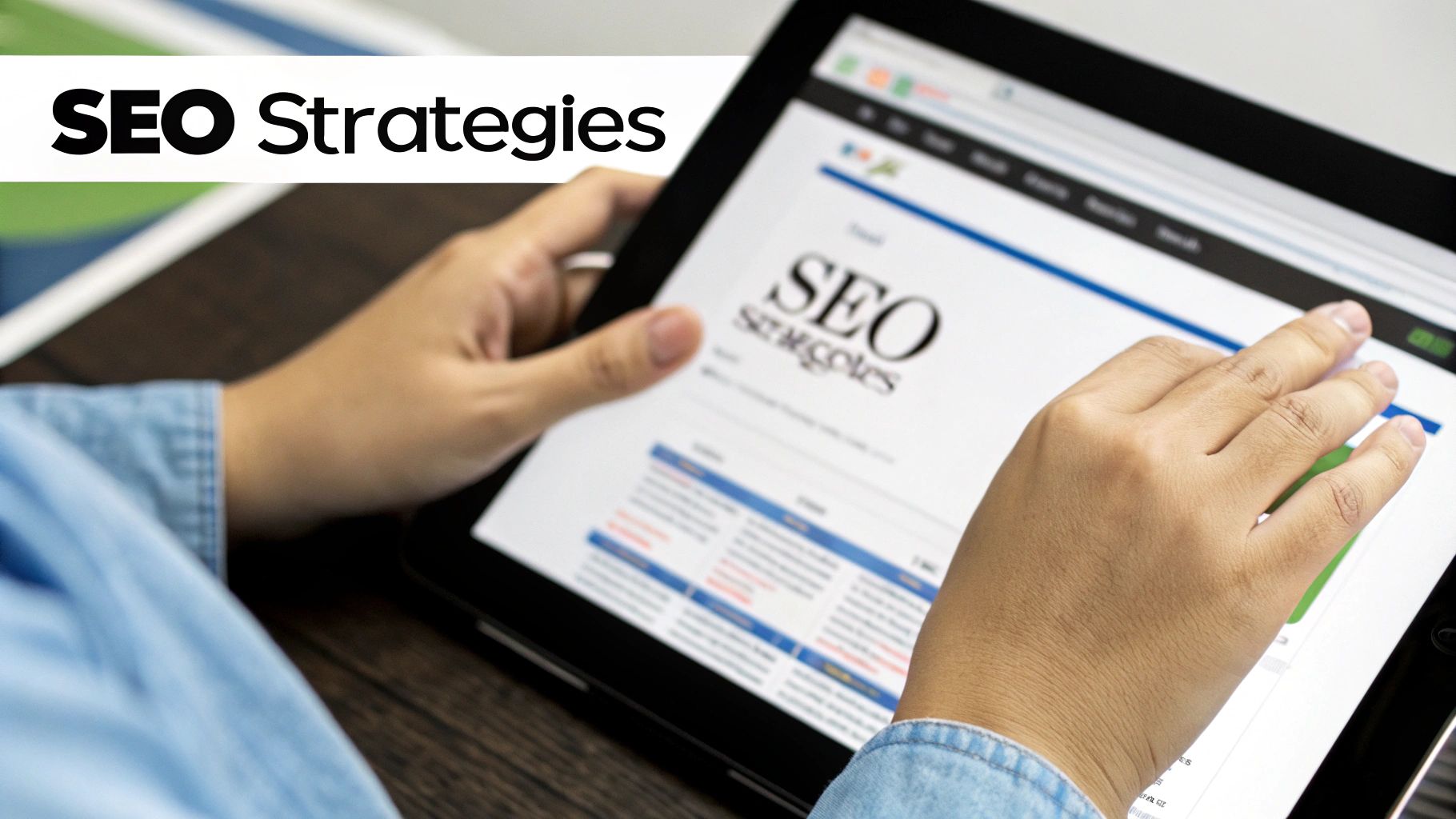
Think of your digital marketing strategy like a specialised toolkit. Each tool has a very specific job, but they only really shine when you use them together. In the fast-paced digital marketing UAE space, your success hinges on knowing which tool to grab and how to use it with skill.
This is where we'll break down the most essential tools in your kit. We'll look at how to make them work in the unique context of the Emirates—from reaching a bilingual audience to showing up on the platforms people scroll through every single day.
Search Engine Optimisation for a Bilingual Audience
Search Engine Optimisation (SEO) is the art of getting your business to show up at the very top of Google when people search for what you do. It’s like setting up your shop on the busiest digital street corner, right where your ideal customers are already walking.
But here in the UAE, this "street corner" has two main languages: Arabic and English. One of the biggest mistakes we see is businesses simply translating their English website into Arabic and calling it a day. Real localisation goes so much deeper—it's about understanding cultural nuances, different search habits, and even regional dialects.
To truly capture the whole market, your SEO strategy has to be genuinely bilingual. This means:
- Keyword Research in Both Languages: You need to discover how both English-speaking expats and Arabic-speaking nationals look for your products. The search terms they use can be worlds apart.
- Culturally Adapted Content: Your website copy, blog posts, and product descriptions must connect culturally, not just linguistically. The tone and references matter.
- Technical SEO for Multilingual Sites: This involves using the right signals (like hreflang tags) to tell Google which language version of a page to show to which user. It’s the behind-the-scenes work that makes the user experience seamless.
Get this right, and you become visible to everyone, no matter what language they type into the search bar.
Key Insight: A winning UAE SEO strategy isn’t a choice between English or Arabic; it's about creating a flawless experience in both. This shows respect for local culture and massively expands your potential customer base.
Pay-Per-Click Advertising for Precision Targeting
While SEO is your long-term game for building authority, Pay-Per-Click (PPC) advertising is all about getting immediate results. Picture it as putting a bright, flashing billboard right in front of someone the exact moment they’re looking for your solution. With platforms like Google Ads, you only pay when someone actually clicks your ad.
The real magic of PPC in the UAE is its incredible precision. In a market this diverse, being able to pinpoint your audience is everything.
You can focus your campaigns by:
- Location: Target specific Emirates, whether it's the bustling heart of Dubai or the capital, Abu Dhabi.
- Language: Show expertly crafted Arabic ads to Arabic speakers and English ads to English speakers.
- Demographics: Zero in on specific age brackets, income levels, and personal interests.
This level of control makes PPC an incredibly efficient way to spend your advertising budget. You’re not just shouting into the void; you're speaking directly to the people most likely to become your next customer. For any business after quick wins and measurable returns, a sharp PPC campaign is a must-have.
Social Media Marketing Where Your Audience Lives
In the UAE, social media isn't just another marketing channel—it's a core part of daily life. With 100% of the population having a social media account, if your business isn't there, you're practically invisible. But just showing up isn't enough. A generic, one-size-fits-all approach is doomed to fail. You need to be on the right platforms, speaking the language of your audience.
Key Platforms and Their Roles
- Instagram & TikTok: These are the visual kings, especially for consumer brands in fashion, food, and lifestyle. Their bite-sized, video-first formats are perfect for grabbing the attention of a younger, hyper-engaged audience.
- LinkedIn: For B2B marketing, LinkedIn is the undisputed champion. It's the go-to platform for professional networking, reaching key decision-makers, and establishing your company as an authority in its field.
- Facebook & WhatsApp: Facebook still holds strong as a community-building hub, while WhatsApp has become essential for direct customer service and one-on-one communication.
A powerful strategy doesn't treat these as separate islands. It weaves them together, using each platform for its unique strengths. Pulling all these strings can feel overwhelming, which is why many businesses turn to expert support. You can explore how professional teams manage this by checking out affordable digital marketing services in the UAE. An integrated approach turns scattered online activity into a well-oiled machine for attracting, engaging, and winning over customers.
Riding the UAE's Digital Advertising Wave
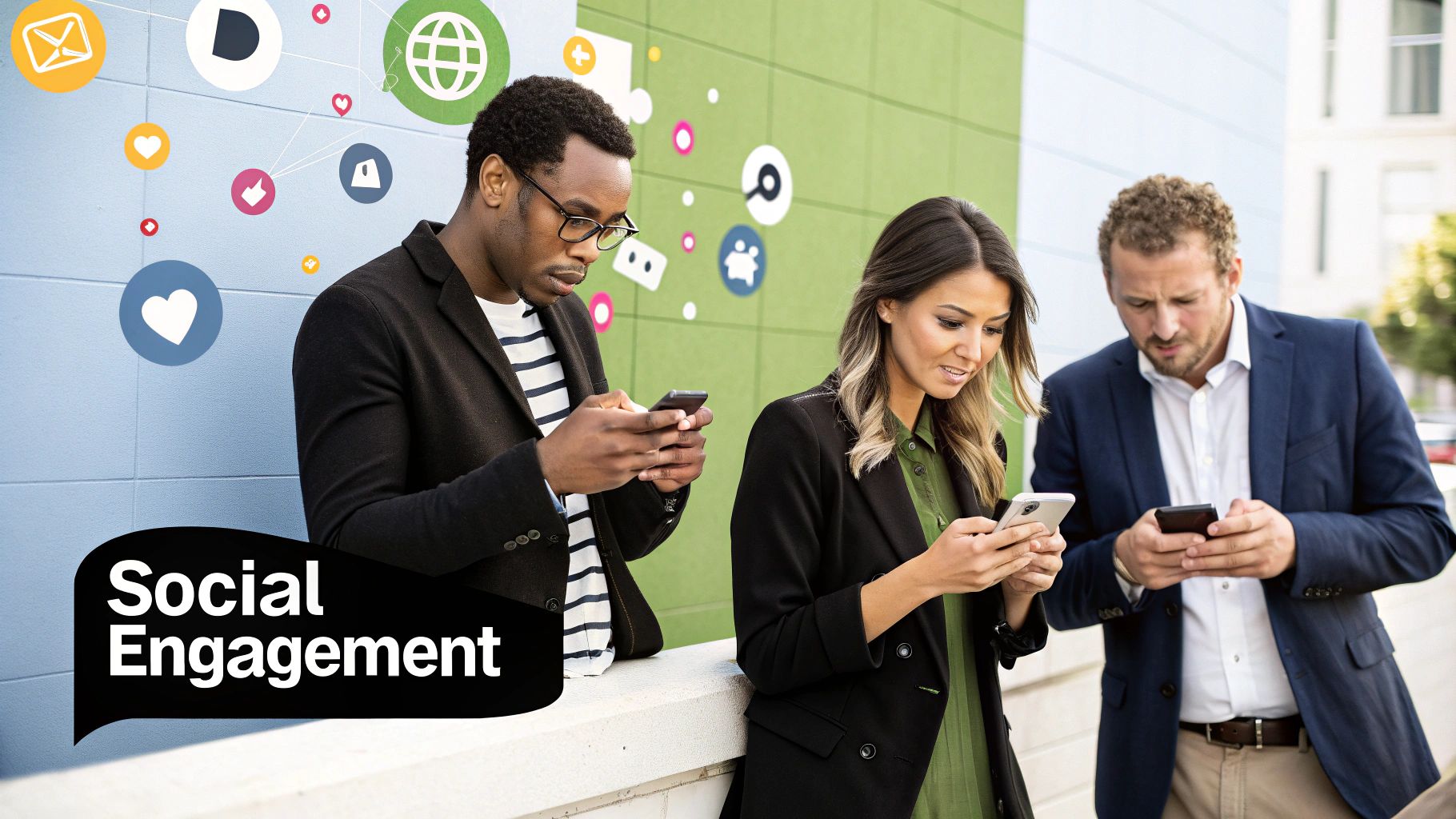
Knowing the digital marketing channels is one side of the coin. The other is understanding the powerful economic engine revving them up. In the UAE, this engine is a full-blown digital advertising boom, supercharged by massive investment and a seismic shift in how people shop and live online.
So, let's step back from the 'how' of each channel for a moment and look at the 'why' behind this explosion. This is the commercial context that makes every single click, view, and impression so incredibly valuable. For any business here, getting a grip on the sheer scale of this market is vital for justifying budgets and building strategies that go where the money and attention are already flowing.
The Sheer Scale of the Digital Ad Market
The digital marketing UAE scene isn't just growing—it's accelerating at a blistering pace. Businesses are decisively shifting their advertising budgets away from traditional media like print and radio. Why? They're pouring them into digital formats where they can get hard numbers, track results, and speak directly to the exact people they want to reach.
This massive migration of ad spend is forging a fiercely competitive, yet incredibly robust, advertising environment. The total digital ad revenue in the UAE is on track to hit around USD 1.71 billion in 2025. That number isn't just a statistic; it's a testament to the unwavering confidence businesses have in these channels.
This growth is tightly woven into the country’s phenomenal e-commerce sector, which is projected to blow past $15 billion by the same year. You can get a closer look at the data behind this trend by exploring the UAE's digital advertising market insights on Statista.com.
It’s a simple, powerful cycle: as more people shop online, the value of digital ads that capture those shoppers skyrockets.
The surge in UAE e-commerce directly fuels the advertising boom. Every online transaction reinforces the value of digital ads, encouraging businesses to invest more heavily in campaigns that drive sales and build brand presence online.
Where Is the Money Actually Going?
Not all ad formats are created equal, especially when it comes to budgets. Pinpointing where the big money is being spent gives you a clear roadmap of what’s truly working in the UAE market. It’s like watching the smart investors and learning from their moves.
Right now, the investment is heavily concentrated in a few key arenas:
- Social Media Advertising: Platforms like Instagram, TikTok, and Facebook are absolute magnets for ad spend. Their ability to target users with surgical precision—based on deep user data—makes them incredibly potent for both consumer brands and B2B companies. Ad spending here is expected to climb to nearly $450 million in 2025.
- Video Advertising: Whether it's a pre-roll ad on YouTube or a snappy video in a social feed, video is king. Its power to tell a story and captivate an audience makes it a top-tier choice for brands wanting to build a genuine connection.
- Search Advertising: The sheer power of intent keeps search ads at the top of the list. Businesses continue to invest heavily to ensure they are the first answer a potential customer sees on Google at the exact moment of need.
- Banner Advertising: It might be one of the oldest digital ad formats, but don't count it out. Display and banner ads still make up the largest single segment, projected to pull in over USD 451.52 million in 2025. It remains the go-to for large-scale brand awareness campaigns.
The Unstoppable Rise of Social Commerce Ads
One of the most powerful trends shaping the ad landscape is the explosion of social commerce. This isn't just advertising; it's about seamlessly blending the shopping experience directly into social media platforms. A user sees a product in a post, taps on it, and buys it—all without ever leaving the app.
This has turned "shoppable ads" into one of the most lethal tools for e-commerce businesses. These are no longer just ads; they're interactive, miniature storefronts.
Imagine a fashion brand running an Instagram ad for its new collection. A user can tap on a dress in the image, see the price, and go straight to checkout. This frictionless journey from discovery to purchase is incredibly potent, driving up conversion rates and delivering a crystal-clear return on ad spend.
Leveraging Advanced Tech and Future Trends
Once you've got a handle on the core channels, it's time to look at what's next. The future of digital marketing in the UAE is all about technology that automates, personalises, and fine-tunes campaigns at a scale that was impossible just a few years ago. To really get ahead, businesses need to move beyond today's basics and start using the tools that are already defining tomorrow's market.
Think of it as upgrading your marketing toolkit. You're moving from standard hand tools to sophisticated, powered equipment. It’s about working smarter, faster, and with far more precision to gain a real competitive edge.
The Rise of Programmatic Advertising
Imagine having an expert ad buyer working for you 24/7. This expert tirelessly finds the perfect ad spots across the internet and negotiates the best price in real-time—all in the blink of an eye. In a nutshell, that's programmatic advertising.
It’s an automated system that uses software to buy and sell digital ad space, completely replacing the old, manual process of phone calls, negotiations, and insertion orders. For a market as fast-paced as the UAE, this kind of efficiency is a total game-changer. It lets you place your ads in front of a very specific audience based on their behaviour, interests, and demographics, no matter where they are online.
Programmatic advertising isn't just about speed; it's about intelligence. It uses data to make split-second decisions, ensuring your ad budget is spent with maximum impact, reaching just the right person at just the right moment.
The growth of this technology is simply staggering. The UAE's digital advertising market is projected to grow at a compound annual rate of 12.0% between 2025 and 2033, a boom driven largely by programmatic buying. In fact, it's estimated that programmatic will account for 76% of all digital ad revenue by 2028. You can find more insights on the future of UAE digital marketing at sapience.ae.
To really understand the shift, it helps to see the old and new methods side-by-side. The traditional way of buying ads involved a lot of guesswork and manual effort. Programmatic, on the other hand, is all about data-driven precision and speed.
Comparing Traditional vs Programmatic Ad Buying
This table breaks down the key differences, showing why programmatic is becoming the standard for modern advertisers.
| Feature | Traditional Ad Buying | Programmatic Ad Buying |
|---|---|---|
| Process | Manual negotiations, phone calls, and paperwork | Automated, real-time bidding via software platforms |
| Targeting | Broad; based on website context (e.g., sports site) | Hyper-specific; based on user data, behaviour, and demographics |
| Speed | Slow; can take days or weeks to launch a campaign | Instant; ads are bought and served in milliseconds |
| Efficiency | Labour-intensive and prone to human error | Highly efficient, with minimal manual intervention |
| Optimisation | Difficult to adjust in real-time | Campaigns are continuously optimised based on performance data |
| Cost | Often higher due to fixed rates and manual overhead | More cost-effective through real-time bidding for ad impressions |
As you can see, programmatic advertising offers a smarter, more direct path to your audience, ensuring your budget is working as hard as possible.
Harnessing Artificial Intelligence for Deeper Connections
If programmatic advertising is the high-performance engine, then Artificial Intelligence (AI) is its incredibly smart driver. AI is the brainpower that crunches massive amounts of data to find patterns and make predictions. This allows for a level of personalisation that builds genuinely strong customer relationships—something that's becoming a must-have in the UAE, where consumers expect sophisticated digital experiences.
Instead of blasting out generic marketing messages, AI helps you create deeply personal customer journeys. Here’s how it’s being used in the real world:
- Predictive Analytics: AI can look at a customer's past behaviour to predict what they might want next, letting you serve up highly relevant product recommendations before they even think to search for them.
- Smart Chatbots: Today's chatbots are far more than simple Q&A bots. They use AI to understand the intent behind a customer's query, providing instant, genuinely helpful support 24/7.
- Dynamic Content: AI can automatically change the content on your website or in your emails to match an individual user's interests, making every visitor feel like the experience was created just for them.
When you start using these tools, you stop broadcasting one message to many and start having a personal conversation with each and every customer.
The Power of Visual Content in the Emirates
While technology handles the delivery, the content itself is still what captures hearts and minds. In the highly visual and mobile-first world of the UAE, some formats just work better than others at grabbing attention and getting people to interact.
The infographic below gives a simple breakdown of how different content types perform in the UAE's digital market.
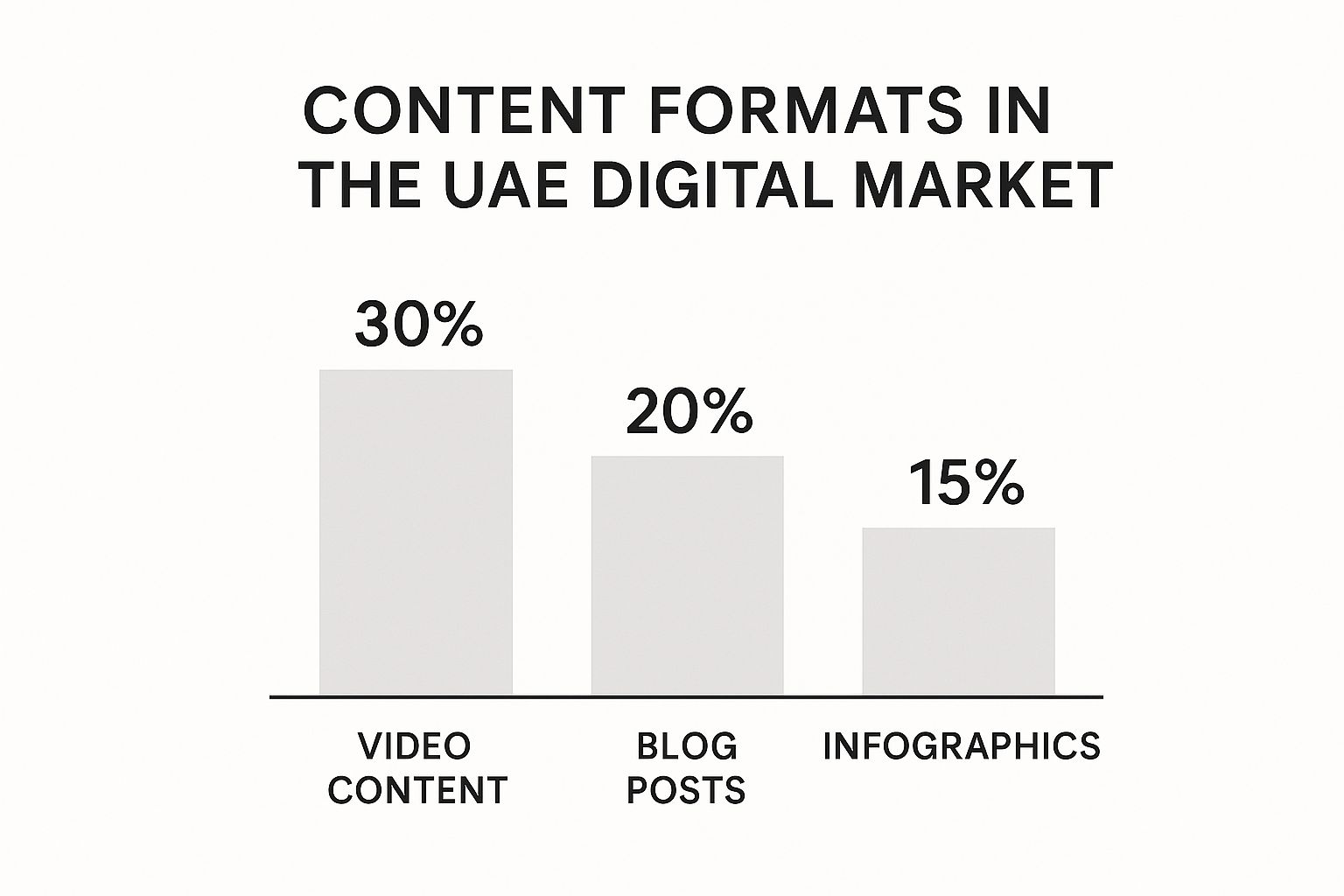
The data speaks for itself. Dynamic, visual formats like video are clear winners, making them a top priority for any content strategy aimed at this region. When you combine advanced tech like AI and programmatic with visually compelling content, you've got a powerful formula for any brand that's serious about growth.
When you’re looking to make a splash in the UAE market, a generic, off-the-shelf marketing plan just won’t cut it. It’ll get lost in a sea of brands all vying for attention. The real secret to success here is localisation—a deep, meaningful strategy that goes way beyond simply translating your website. It’s about feeling the unique pulse of the region and moving in rhythm with it.
To build a genuine connection, you have to get granular. Your entire approach needs to be shaped by local behaviours, specific preferences, and important cultural moments. This influences everything from the words you choose to the payment options you offer, ultimately building the trust you need to create customers for life.
Beyond Translation to Cultural Resonance
One of the most common mistakes businesses make when entering the UAE is treating language as a simple box to tick. A word-for-word translation of your English marketing copy into Arabic rarely works. More often than not, it comes across as stiff, unnatural, or worse, culturally tone-deaf.
Truly effective localisation demands a thoughtful, bilingual approach. While English is spoken everywhere, especially in business circles and among the large expat community, Arabic is the language of heritage, family, and home. A brand that can communicate fluently and respectfully in both sends a powerful message.
Key Takeaway: Authentic communication in the UAE isn’t an either/or choice between English and Arabic. It’s about crafting messages in both languages that connect on a cultural level. This shows you’re committed and respectful—two qualities that are absolutely foundational for building consumer trust here.
Aligning with Local Consumer Behaviours
To build a strategy that actually gets results, you have to meet UAE consumers where they are and how they prefer to shop. This means tailoring both your marketing and your operations to match their expectations.
A few key behaviours really stand out:
- Platform Preferences: Don't just assume the social media giants from your home country rule the roost here. Instagram and TikTok are absolute powerhouses for visual, B2C marketing. But for B2B, LinkedIn is non-negotiable, and you can’t overlook WhatsApp as a vital channel for direct customer service and communication.
- Payment Method Diversity: While credit cards are common, a huge part of the population still prefers or feels more secure with Cash on Delivery (COD). If you don't offer it, you risk losing a massive chunk of potential sales by alienating a key segment of online shoppers.
- Mobile-First Expectations: Smartphone ownership is practically universal in the UAE. A flawless mobile experience isn't a nice-to-have; it's the absolute baseline. Think mobile-optimised websites, frictionless in-app purchasing, and ads designed from the ground up for vertical screens.
Getting these fundamentals right is crucial. For a deeper dive into creating a robust operational framework, it’s worth exploring insights on building a powerful ecommerce digital marketing strategy, which offers a solid blueprint that can be adapted for the UAE market.
The Power of Cultural and Religious Timings
Marketing in the UAE isn’t a flat, year-round schedule. It flows with the rhythm of major cultural and religious events. Timing your campaigns to align with these moments is the key to staying relevant and making an impact.
Ramadan and Eid: This is, without a doubt, the most important period of the year. Consumer behaviour changes dramatically. You’ll see online activity and e-commerce spending spike in the evenings after Iftar.
- Messaging: Your tone should shift to focus on themes of family, community, generosity, and reflection. Hard-sell, aggressive tactics will fall completely flat.
- Offers: Promotions centred around gifts, food, and family-oriented activities and products tend to perform incredibly well.
UAE National Day: This is a celebration of immense national pride. Campaigns that honour the nation's heritage, progress, and achievements can forge a powerful emotional bond with Emiratis and long-term residents alike.
If your brand ignores these major events, you’ll stick out like a sore thumb—and not in a good way. A well-timed, culturally sensitive campaign, on the other hand, shows you’re not just a foreign company doing business here; you’re part of the community. This local-first mindset is also vital for getting noticed online; learning how to improve local SEO is essential for ensuring customers in your area can actually find you. Successfully weaving all of these threads—cultural, behavioural, and linguistic—is what a winning digital marketing UAE strategy is all about.
Measuring What Matters in Your UAE Campaigns
A brilliant campaign without measurement is just guesswork. It's the final, critical piece of any successful digital marketing UAE strategy—the ability to track, analyse, and ultimately refine your efforts for real business impact. This is where you separate what feels good from what actually grows the bottom line.
Think of it like a ship's captain navigating the Arabian Gulf. You wouldn't just point your vessel in a general direction and hope for the best. You’d be constantly checking your compass, charts, and weather reports to make sure you're on course. Your campaign metrics are those very navigational tools.
The real goal is to move beyond "vanity metrics" like raw follower counts and focus on the Key Performance Indicators (KPIs) that directly map back to your business objectives. This means the numbers you obsess over for a brand awareness campaign will look very different from what you track for a lead generation or e-commerce push.
Aligning Your KPIs with Business Goals
First things first: what does a "win" actually look like for this specific campaign? Are you trying to get more people to know your brand exists, or are you trying to sell a product today? Your answer dictates which data points matter.
A mismatch here is a classic pitfall. We've seen businesses chase high click-through rates when their primary goal was brand awareness, leading them to make poor strategic decisions based on the wrong signals.
Here’s a simple breakdown of which KPIs to focus on for common objectives:
- For Brand Awareness: Track metrics like Reach (how many unique people see your content), Impressions (how many times your content is displayed), and Video View-Through Rate. These tell you how far and wide your message is spreading.
- For Lead Generation: Zero in on the Conversion Rate of your landing pages, your Cost Per Lead (CPL), and the number of Marketing Qualified Leads (MQLs) you're generating. This is all about efficiency and the quality of the leads.
- For E-commerce Sales: This is where the money is. The most important metrics are Return on Ad Spend (ROAS), Average Order Value (AOV), and Customer Lifetime Value (CLV). This is direct, revenue-focused measurement.
The most powerful mental shift you can make is from asking "How many people saw our ad?" to "What action did the right people take after seeing our ad?" This focus on outcomes is what drives a measurable return on investment (ROI).
The Continuous Cycle of Optimisation
Data is only useful if you act on it. The best marketers operate in a continuous cycle: test, learn, and refine. This isn't a one-time setup; it's an ongoing process of improvement.
Use tools like Google Analytics and the built-in insights from social media platforms to understand user behaviour. Where are people dropping off in your sales funnel? Which ad creative is generating the most buzz? These clues are your roadmap for what to fix and what to double down on. For a more structured approach, you can explore the fundamentals of effective marketing campaign tracking to build a solid foundation.
To put this into practice, using a solid social media analytics report template can help you organise and make sense of all the performance data. This simple step helps turn raw numbers into clear, actionable insights, making it far easier to explain your findings and justify strategic changes. This kind of data-driven decision-making is the real engine of sustainable growth.
Answering Your Top UAE Marketing Questions
When you're diving into the unique world of digital marketing in the UAE, it's natural to have questions. Getting solid answers upfront helps you avoid common mistakes and build a smarter, more effective strategy from day one.
Let’s tackle some of the most pressing questions we hear from businesses looking to make their mark in this vibrant market.
How Much Should a Small Business Budget for Marketing?
There's no single "magic number" that works for everyone. Your marketing budget will always depend on your industry, your specific goals, and just how fierce the competition is.
That said, a sensible starting point for many small businesses in the UAE is to earmark between 7% and 12% of their total revenue for digital marketing.
The smartest way forward? Start with a smaller, test budget for a couple of months. Focus your spend on one or two channels with high potential—maybe local SEO and a targeted Instagram campaign. Then, watch your return on investment like a hawk. Once you see what’s actually bringing in results, you can scale your budget up with confidence.
Is English or Arabic More Important for UAE Campaigns?
The honest answer is: you absolutely need both. The UAE is a massive international hub, packed with a diverse expatriate community. This makes English a must-have to cast a wide net.
At the same time, Arabic is the official language and the heart of the local culture. Speaking it fluently in your marketing is vital for genuinely connecting with Emirati nationals and the wider Arabic-speaking population.
A bilingual strategy isn’t a luxury here—it’s a baseline requirement for maximising your reach and showing genuine cultural respect. Make sure your website, major ad campaigns, and social media are all professionally localised in both languages.
Which Social Media Platform Is Best for Business?
The "best" platform is wherever your ideal customer spends their time. It’s all about focusing your energy where your audience is already active and engaged.
- For B2C brands with visual appeal (think fashion, food, or beauty) going after a younger crowd, Instagram and TikTok are king.
- For B2B companies or anyone targeting high-income professionals, LinkedIn is non-negotiable for building authority and professional networks.
- Facebook is still a powerhouse across a huge demographic, perfect for building communities and running incredibly specific local ads.
For more deep dives into digital strategies and answers to common marketing challenges, you can find some great perspectives in the insights from the Rebelgrowth blog.
Ready to stop guessing and start seeing real, measurable results from your marketing? The team at Technogital F.Z.C specialises in creating data-driven strategies that deliver growth. Get in touch with us today and let's talk about how we can help your business thrive online.
